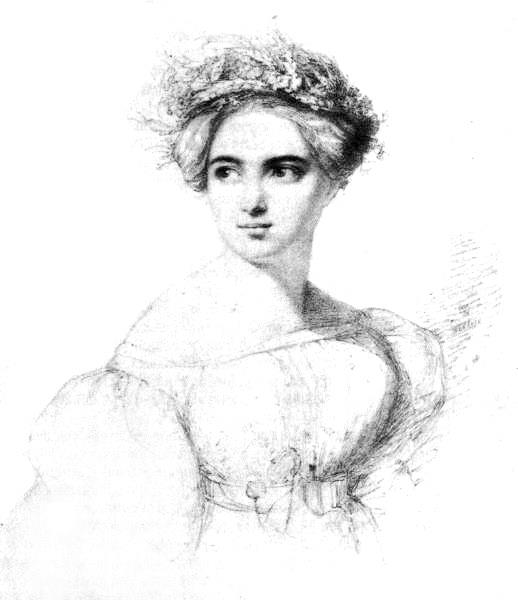
Music Period: Romantic era (1830 – 1900)
Location: Berlin, Germany
Claim to Fame: composing over 400 works in her lifetime, and being the only composer of the time to depict each of the twelve months of the year musically. The closest any other composer came to doing this was Antonio Vivaldi with his Four Seasons in 1725.
Fanny Mendelssohn (1805 – 1847) was one of the most important composers of the Romantic era. She performed and conducted music on a regular basis, earning her a reputation as an exceptional musical talent. Berlin music critic, Ludwig Rellstab, wrote that she “had achieved a level of musical knowledge which few other artists who have dedicated their lives to music could claim”. Yet due to the restrictions of her social class and the ideals of her father, Fanny would remain a private figure for most of her life. This has led to her being lost to music history for the past 150 years.
Fanny received an excellent education from an early age and received instruction from the best music teachers available. She spent several months in 1816 studying the piano in Paris alongside her brother, Felix Mendelssohn. They both then received instruction in music theory and composition by Carl Friedrich Zelter upon their return to Berlin. From this moment forward, each sought the criticisms of the other when composing. Each valued the opinion of the other dearly.
The Mendelssohn social circle soon came to know Fanny for her lieder and piano compositions. It would be several years, however, before any of her works would be published. This was due to several restrictions Fanny faced. The first was her father. He thought it her womanly duty to take up the role of wife and mother, despite his encouragement of his daughter as a musician. It was also considered inappropriate for an upper-class woman to be performing in public and assume any kind of professional identity. Fanny was, therefore, restricted to the domestic realm like many other women around her.
There was some hope though. The Mendelssohn family held regular evening concerts at their home for family friends. It was at these concerts – known as “Sonntagsmusiken” – where Fanny performed the majority of her compositions to a handpicked audience. These concerts stopped in 1829 when Felix left home for his first extended visit to England. They were revived by Fanny in 1831 and soon became well attended. Ludwig Rellstab, the music critic, writes that the concerts were “a musical festival of the most unusual sort, in which meticulous interpretations of classical works of former and current time could be heard and the pleasure was enhanced by the performances or mere presence of the very best Berlin musicians or those from elsewhere who visited our city.” Fanny Mendelssohn herself featured in the concert repertoire. She also conducted and accompanied her choir, which consisted of twenty singers. Instrumentalists sometimes joined the choir and together they performed works by composers such as Mozart, Beethoven, and Weber. It was these concerts where Fanny was able to make her works known.
Towards the end of the 1820s, Fanny grasped an opportunity to publish a handful of her works under the name of her brother in his Liederheften Op.8 and Op.9. From that moment, Fanny started to compose larger works for soloists, choirs, and orchestras. It would be a few more years before Fanny received recognition for her works beyond the family circle. This came whilst travelling in Italy from 1839-1840. It was in Italy that Fanny became acquainted with various musicians who thought highly of her work and supported her creativity. The trip would encourage Fanny to compose her most important piano work, Das Jahr, in 1841. Das Jahr is a work that musically depicts each of the twelve months of the year. Fanny Mendelssohn was the only composer of her time to use this idea. There had been a glimpse of something similar 116 years previously when the four seasons were transformed into musical works now known the world over.
It would be in the last year of her life that Fanny Mendelssohn decided to accept offers to publish some of her works. This went against explicit instructions from her brother. Felix held the same ideals as his father, and believed it was inappropriate for a woman to publish her musical works. The works were published despite this, and received favourable reviews from the musical press. Fanny, however, would not see any further publications of her work. She died suddenly of a stroke during a rehearsal for one of her concerts on 14th May 1847. It would be Wilhelm Hensel, her husband, who would ensure more of her works were published. We see a handful more of Fanny’s works published in 1850, but from there, the process lies dormant until 137 years later, when Furore Verlang published some of her unprinted works in 1987. Despite this, we still lack a publication solely for Das Jahr that is widely available, or a definitive collection that holds more than a dozen of her 400 or so works.
You can learn more about Fanny Mendelssohn here and here.
Sounds and Sweet Airs: the Forgotten Women of Classical Music (2016), by Anna Beer is a particularly interesting read and is highly recommended if you want to find out more.
-Claire Amundson
Junior Girl
Girl Museum Inc.
